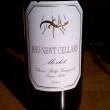This Is Your Grape. This Is Your Grape On Downy Mildew.
By Evan Dawson, Finger Lakes Editor
Photo by Morgan Dawson Photography
Downy mildew is like the slasher movie killer in the vineyard: You almost never see it, but when it does make an appearance there is a trail of destruction in its wake.
And all summer long, we heard how this was a disease pressure year like few others — a slasher movie, to be sure, in the unsuspecting vineyards.
Check out this photograph of grapes ravaged by downy mildew. It was taken in a Finger Lakes vineyard that serves only as an experimental block and thus is not designed to make wine. But the grapes we visited were a mix of vinifera, hybrids and natives.
In the case of this particular block, there was no spraying throughout the growing season. The cool and near-constant early season rains brought a lot of problems and without a spraying regimen, these vines were at the mercy of the mildew.
Pretty sad, huh?
The good news is that growing practices are improving, and even in this pressurized season, many growers have risen to the challenge. That does, of course, require spraying for most of them.
On Long Island and in other regions, an organic movement is growing that eschews traditional spraying in favor of other means of fighting disease. That's a post for another day. I certainly don't intend with this post to endorse one form of growing practice over another; I only intend to illustrate exactly what the effects of downy mildew look like.
For industry professionals, it's nothing new. For those of us who don't tend the vines every day, it's might be something new indeed. And by the way, the solution to warding off disease is not as simple as, "Spray!" It's obviously more complicated and nuanced than that. No doubt growers can spray too often or too rarely. We'd love for growers to jump in to the comments here and share their ideas for handling this season.
Please forgive my hat hair in this video. There's no evidence that my hair was hit by downy mildew. As far as you know.


















Organic copper is the “spray” for downy mildew. Overuse of copper can have a negative impact on soil health so we rotate copper with phosphite. Phosphite formulations are in the process of becoming certified organic. All vineyards everywhere in the world need to “spray” whether they are practicing organics or not.
David -
You use organic copper and phosphite. What are some of the products that other growers use?
great video evan - very informative look at the mysterious Downey Mildew!
I asked some North Georgia growers about organic practices this past weekend, and they just laughed. Sounds like Downy, Powdery, and Pierce’s Disease are huge challenges with the vinifera on the Dahlonega Plateau…really respect these guys more when you realize what they go through from grape to glass.
Evan,
We are out of the loop regarding the names of the chemical fungicides conventional growers use.
Evan - this has indeed been a really difficult year for disease management, particularly downy mildew. Growers have had to use more spray materials this year than normal, unfortunately, but as you note in the video if they don’t do it, they don’t have any kind of crop at all.
There are a number of materials that growers use to protect against downy mildew infections. The best ones are used closer to bloom time when the clusters and new berries are very vulnerable to infection. By about 4-6 weeks after bloom, the berries are resistant to new infections but the leaves remain vulnerable all season long - thus the need to continue spraying the canopies later in the season. There really is only one type of material that is effective at killing existing infections - that’s the phosphite material that David mentioned. It’s a great material (sold under several different trade names), but overuse can cause the fungus to become resistant over time. This has happened to some other materials here in NY, so we try to encourage growers to not rely on those materials alone. Other than that, everything else works to prevent infections.
There are some vineyards in NY and elsewhere who try to keep their practices as close to organic as possible, but don’t officially certify themselves because of years like this. It’s important to be able to have the flexibility to use stronger, non-organic materials when heavier disease pressure makes it necessary to do so. Organic growers, meanwhile, have a difficult decision to make in those years - use a non-certified material, save your crop but lose your certification, or hope that the organic materials will be sufficient.
Given the high pressure that we have had for much of this season, most of the vineyards I have visited this year are still in pretty good shape, thanks to a lot of hard work on the part of the growers this year. Let’s hope this first week of September is a harbinger of the next couple of months.
Hans Walter-Peterson
Finger Lakes Grape Program
Hans -
Wonderful to hear from you. This is all very insightful — not only for writers, bloggers, and members of the industry, but also for day-to-day consumers. Lenn and I speak often about the importance of providing content that appeals to people outside the blogging bubble. I truly believe comments like yours go a long way to helping wine consumers understand the product.
I hope you (and some other growers and our science editor, if possible) might answer a question that has been nagging at me since the start of this month. We so often hear that, this time of year, “Grapes love warm days and cool nights.” We hear it’s beneficial to structure, that an 80-degree day and 50-degree night helps bring complexity. Are there physiological reasons to believe this?
Thanks again and cheers.
Evan,
JMS stylet oil - which is a highly purified mineral oil - as well as elemental sulfur are 2 other organic materials that are widely used by most growers on Long Island to fight mildew - mostly powdery. The oil also has some effect on controlling detrimental mite populations in the vineyard while leaving other beneficial insects alone.
Evan and Lenn,
This is why the NY Cork Report rocks in my opinion. You educate people like no other.
Wonderful job and the pictures and video are great.
For someone finding this blog for the first time or someone that has been reading for a while, you keep our attention!
Keep up the great work…
I’d be curious to hear how/why these treatments work for mildew.
David? Hans? Rich?
This kind of discussion is fascinating. Wine is truly amazing to me…the more I learn the more I realize how little I know.
Michael - You’re too kind. Of course, we tend to scratch the surface in a post and the best stuff comes in the comments, as you’re seeing here. We love to see a wide range of participation, and you’ll see more of that in the months to come.
Thanks for that comment, Michael. It’s truly appreciated.
This is a blog. What does that mean? It means that it’s only as good as the combined efforts of the authors and the readers. Without readers contributing comments (like those above), this site would be awfully boring.
Lenn: Sulfur (spread as elemental but quickly oxidized to SO2) inhibits a variety of enzymes in a whole bunch of organisms, so its method of action is unknown but it’s totally destructive for some organisms (bacteria and mold)
the stylet oil works by (1) disrupting the membranes of the molds and (2) physically preventing the mold from contact with the leaf.
Evan:
re: Hot days, cool nights. It’s been known that grapes with hot days and hot nights develop less color (anthocyanins), and recently the enzymatic basis for this has been elucidated to be reduced production of anthocyanin-making enzymes under warm conditions (http://tinyurl.com/kwmkur). I imagine that grapes have evolved to adapt to temperature fluctuations by changing their functions throughout the day.
I think that you could sum it up simplistically by saying the plant makes its food during the day (photosynthesis) and then uses that food energy at night to build aroma and flavor compounds.
Tom - Exactly what I was looking for. Great stuff, Science Ed. Thanks.
Just to add to Tom’s points - materials like sulfur, certain salts and oils work against powdery mildew because the fungus resides primarily on the surface of the leaf, where these materials can act on the organism directly. These materials have almost no effect on downy mildew or other fungal diseases because they live inside the tissue. To get at those diseases, you need something that is more ‘systemic’ - something that can get into the plant tissues as well and possibly be translocated to some extent. The phosphite products are an example of this.
The ‘hot days, cool nights’ idea primarily comes from warmer grape growing climates, like California, I think. Studies have shown differences in the amount of malic acid in grapes from vines grown at the same daytime temperature but different night temperatures. More malate remains with cooler evening temps due to lower respiration rates (malate is burned up in respiration by the berries). In climates where they can have too little acid in their fruit (i.e., hotter growing regions), having cool nights that will help to retain some acidity would be beneficial. Thus why so many vineyards have developed in “cooler” areas of California like Carneros and Santa Maria.
Here in NY, we usually don’t have to worry about loss of too much acid (2007 was a bit of an anomaly), so I’m not sure that it makes as much of a difference for us - from this particular standpoint at least.
hans:
clearly i am still slightly out of my league when it comes to viticulture, but i’m learning! thanks for chiming in.
Cornell / NYS Ag Expt Station, Geneva, has an ongoing program to develop new wine grape varieties that require no sprays at all. This was a great test year for our program, and there are a number of selections that look great despite the extreme downy mildew pressure this year. One selection in particular is already going out to test vineyards in the Finger Lakes and in other states as well. Watch for further developments in the future!